Abstract
Water is one of the key limiting factors in arid, semiarid, and subhumid lands throughout Africa. Reducing the labor demand involved in the daily efforts to find and haul water releases available time to women to pursue productive agricultural activities and care for their families. This, in turn, improves resilience at the household and community level. Sand dams have proven an excellent way to do this in the subhumid and semiarid areas of Kitui, Machakos, and Makueni Counties in Kenya and are spreading further inside and outside the country. The key to building a sand dam is community involvement from the earliest stage in the process. Locally controlled and organized NGOs are the primary promoters of this activity. The community development groups, called self-help groups, site the dam, prepare the supporting infrastructure, build the dam, and coordinate local control of the new resource. This then drops the water collection time from more than 3 hours per day to as little as 15 minutes. The work then continues with promotion of drought-resistant crops, better fodder supply, and income security.
Most of this article is based on my work with two nongovernment organizations, SASOL and the Utooni Development Organization (UDO) in 2009, 2011, and 2013, spending time building dams, visiting even more sites, and conversing with their leaders, field workers, and area farmers. Field work was done with field agents of UDO and five students from the Kenya Field School, a study abroad program of James Madison University. All the pictures are mine.
Access this chapter
Tax calculation will be finalised at checkout
Purchases are for personal use only
Notes
- 1.
Joshua Mukusya, personal communication July 2011.
- 2.
We tested some sand dams near this rock catchment on a large, ephemeral stream. These dams are managed by the Kithito kya Atumia na Iveti SHG and the Ilikoni Beekeepers SHG and averaged just under 3000 ppm salinity. The full data is found in Table 1 toward the end of this chapter.
- 3.
FAO Pennisetum purpureum: http://www.fao.org/ag/agp/AGPC/doc/gbase/data/Pf000301.HTM
- 4.
Eucalyptus and Grevillea are both Australian imports used for firewood. Grevillea does well when close to crops as it does not compete for nutrients and its shade is light. Croton megalocarpus is a favorite native shade tree whose leaves make good mulch.
- 5.
Both of these figures come from materials in the UDO offices in Kola and are based on their costs for building a sand dam and local average costs for construction of a borehole with a diesel-powered pump and an aboveground storage tank.
References
Borst L, de Haas SA (2006) Hydrology of sand storage dams: a case study in the Kiindu catchment, Kitui District, Kenya. 1 February 2006. Master Thesis Hydrogeology (Code 450122, 27 ECTS), Faculty of Earth and Life Sciences, Vrije University, Amsterdam
Hut R, Ertsen M, Joeman N, Vergeer N, Winsemius H, van de Giesen N (2007) Effects of sand storage dams on groundwater levels with examples from Kenya. Phys Chem Earth 33(2008):56–66
Lal R (2016) Soil health and carbon management. Food Energy Sec 5:212. https://onlinelibrary.wiley.com/doi/full/10.1002/fes3.96
Mutiso GCK (2002) Kitui sand dams: social and economic impacts. Muticon, Nairobi
Ryan C (2012) The potential for sand dams to increase the adaptive capacity of drylands to climate change. Thesis, Masters of Science in Climate Change Management, Birkbeck College, University of London
Teel WS (1994) Catching the rain: agroforestry and soil conservation in Nampula, Mozambique. Dissertation, Cornell University, Ithaca, NY
Tiffen M, Mortimere M, Gichiki F (1994) More people, less Erosion: environmental recovery in Kenya. Wiley, Chichester
Utooni Development Organization (n.d..) http://www.utoonidevelopment.org/
World Resources Institute (n.d.) Chapter 1: ecosystems and ecosystem services (slide show – slide #4). http://www.slideshare.net/WorldResources/naturesbenefits-kenya-01
Author information
Authors and Affiliations
Corresponding author
Editor information
Editors and Affiliations
Rights and permissions
Copyright information
© 2019 Springer Nature Switzerland AG
About this chapter
Cite this chapter
Teel, W.S. (2019). Catching Rain: Sand Dams and Other Strategies for Developing Locally Resilient Water Supplies in Semiarid Areas of Kenya. In: Bamutaze, Y., Kyamanywa, S., Singh, B., Nabanoga, G., Lal, R. (eds) Agriculture and Ecosystem Resilience in Sub Saharan Africa. Climate Change Management. Springer, Cham. https://doi.org/10.1007/978-3-030-12974-3_15
Download citation
DOI: https://doi.org/10.1007/978-3-030-12974-3_15
Published:
Publisher Name: Springer, Cham
Print ISBN: 978-3-030-12973-6
Online ISBN: 978-3-030-12974-3
eBook Packages: Earth and Environmental ScienceEarth and Environmental Science (R0)

